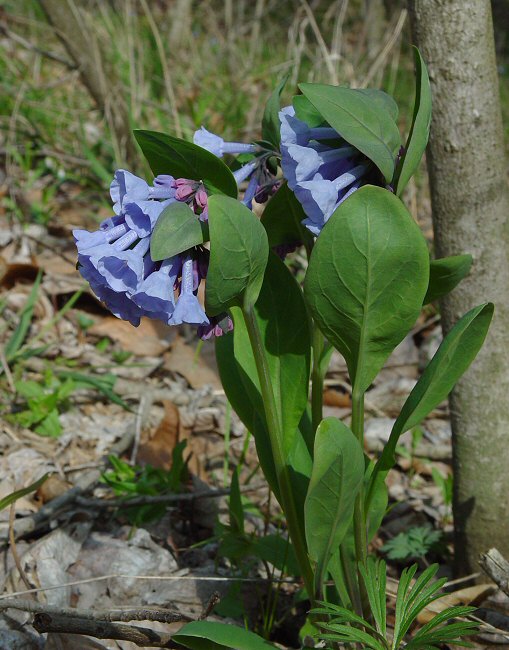Mertensia virginica (L.) Pers. ex Link
Bluebells

Native
CC = 6
CW = 0
MOC = 63
© DETenaglia
Mertensia virginica (L.) Pers. ex LinkBluebells | |
 |
Native CC = 6 CW = 0 MOC = 63 |
© DETenaglia |
|
Family - Boraginaceae Habit - Perennial forb with a stout, woody, branched, often somewhat rhizomatous rootstock. Stems - Ascending or arched, to 70 cm, solitary or more commonly few to several, unbranched or few-branched below the inflorescence, green with some purple at base, with a loose pith, glabrous, usually somewhat glaucous.
Leaves - Alternate and basal, simple. Basal leaves mostly with long, usually winged petioles, the stem leaves mostly short-petiolate, the upper leaves sometimes sessile, the bases usually extending down the stem as narrow wings or ridges. Leaf blades 4-35 cm long, 15-130 mm wide, broadly ovate to obovate, tapered at the base or those of the upper leaves sometimes rounded, rounded or angled to a bluntly or less commonly sharply pointed tip, those of the largest leaves occasionally shallowly notched, the surfaces glabrous or nearly so, particularly the undersurface often glaucous, with 3-6 noticeable pairs of arching lateral veins.
Inflorescences - Dense terminal clusters at the start of flowering, becoming slightly elongated into short, somewhat scorpioid, spikelike racemes with often pendent flowers, these continuing to elongate as the fruits mature, often appearing aggregated into leafy panicles, the flowers with stalks 2-5 mm long, these elongating to 4-12 mm at fruiting, usually spreading to drooping, the flowers lacking bracts.
Flowers - Calyces actinomorphic, 5-lobed about the midpoint, the lobes 2-5 mm long at flowering, lanceolate to oblong-ovate, glabrous, often somewhat glaucous, persistent and ascending at fruiting. Corollas 18-28 mm long, broadly funnelform, actinomorphic, usually pink in bud and blue at flowering, the tube 10-14 mm long, the throat with minute, inconspicuous, scalelike appendages, the broad lobes 1-2 mm long. Stamens 5, inserted near the tip of the corolla tube, the filaments relatively short, the anthers oblong, usually slightly exserted from the corolla. Ovary deeply 4-lobed, the style elongate, exserted from the corolla, usually somewhat withered but persistent at fruiting, the stigma capitate, unlobed.
Fruits - Schizocarps dividing into mostly 4 nutlets, these 3-4 mm long, erect or nearly so, angular-ovoid with a relatively sharp ventral keel, attached to the mound-shaped to shallowly pyramidal gynobase at or just below the base of the ventral keel, the attachment scar relatively small, mostly bluntly pointed at the usually slightly oblique tip, the surface wrinkled, dull brown to dark brown.
Flowering - March - June. Habitat - Bottomland and mesic forests, ravines, swamps, bases and ledges of bluffs, streambanks. Origin - Native to the U.S. Lookalikes - None. Other info. - This striking wildflower is common across the eastern 2/3 of Missouri and much of the U.S. Midwest, ranging into New England and Canada. It is easily recognized when in flower, since there is nothing else in the state which resembles it. The plant is particular to alluvial soils in wooded stream corridors, and under favorable conditions will form extensive colonies. The stems of the plant are somewhat succulent and nearly hollow, so the plant is fragile. It grows well from seed and should be cultivated more. Pink and white-flowered forms are mentioned by Steyermark and are rare in Missouri. Photographs taken at Whetstone Creek Conservation Area, Callaway County, MO., 4-13-04 (DETenaglia); also at Shaw Nature Reserve, Franklin County, MO, 4-9-2006, St. Francois State Park, St. Francois County, MO, 3-28-2016, and Young Conservation Area, Jefferson County, MO, 4-15-2020 (SRTurner). |